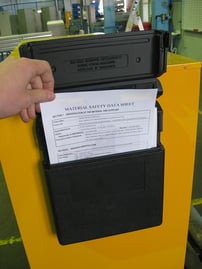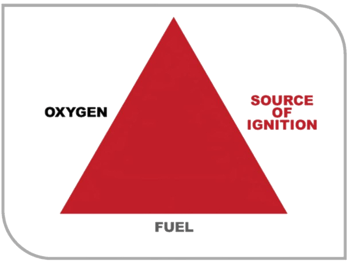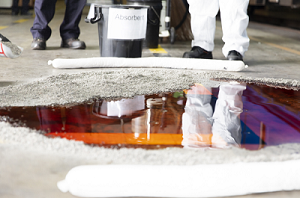You’re most likely aware that flammable liquids are dangerous substances, but did you know that it’s not actually the liquid that burns? When flammable vapours are emitted from the liquid chemical, they mix with the air and ignite in the presence of an ignition source. To successfully manage the many risks involved with Class 3 Flammable Liquids, you must also understand if the chemical is explosive, volatile, corrosive, toxic or carcinogenic. To help you through this minefield, this blog explains the ways that you can reduce the risk of fires, flashbacks and other hazards associated with flammable liquids. We’ll also explain the inherent hazards of flammable liquids — and how your storage and handling practices can help keep your business and community safe.
Physical Hazards
In order to fully understand a fire hazard and the potential for danger, you must know (and understand) a chemical’s flammable range, auto-ignition temperatures, volatility and flash point. You’ll find all this information on the Safety Data Sheet (SDS).
 Flammable liquids are hazardous substances and should be treated with the utmost care. Refer to your SDS to understand the hazards associated with the chemical that you are using.
Flammable liquids are hazardous substances and should be treated with the utmost care. Refer to your SDS to understand the hazards associated with the chemical that you are using.
Fire, Flashpoint and Flashback
As we mentioned, it’s not the flammable liquid that burns — it’s the flammable vapours that are emitted from the chemical.
The lowest temperature at which the chemical can evaporate and produce enough vapours to ignite and continue burning is called the liquid’s flash point.

The flash point of your flammable liquids indicates the lowest temperature that the chemical can ignite and burn.
Flammable liquids are classified according to their flash point. In Australia, any flammable liquids that have a flash point of less than 60°C are classified as Dangerous Goods.
IMPORTANT: All Dangerous Goods (including Class 3 Flammable Liquids) have mandatory labelling, transport and storage requirements specified by the Australian Dangerous Goods Code (ADG Code).
Chemicals with a flash point that sits within normal working temperatures (ie a low flash point) present a high fire risk to your business.
 To reduce the risk of fire and explosion, flammable liquids must be kept away from any type of ignition source within the workplace.
To reduce the risk of fire and explosion, flammable liquids must be kept away from any type of ignition source within the workplace.
These chemicals must be isolated from any type of ignition source, whether it’s thermal, mechanical, electrical or chemical. Ignition sources are everywhere in the average workplace, with sources including naked flames, heat, sparks and static discharge.
FLASHBACK: When a container of flammable liquids is opened, vapours escape into the air. These flammable vapours are denser than air. They can travel for hundreds of metres and still be capable of igniting and burning. When a vapour trail ignites and burns, this is called a ‘flashback’.
Auto-ignition and Explosions
Flammable liquids should be stored in dedicated safety cabinets which are manufactured in accordance with Australia Standards. By storing flammable liquids in a flammable cabinet, you’ll prevent the temperature and concentration of the chemical from reaching its auto-ignition and explosive range.
- Auto-ignition - is the temperature at which the chemical will start to burn and sustain a fire without any ignition source.
- Explosive range - is the temperature range (and concentration levels) where the chemical can explode.
IMPORTANT: Always check the SDS to ascertain flash point, auto-ignition temperatures and explosive range — as these vary for each and every flammable substance.
 To safely store and handle flammable liquids, you must refer to the SDS to learn the physical properties of the substances such as the explosive range.
To safely store and handle flammable liquids, you must refer to the SDS to learn the physical properties of the substances such as the explosive range.
Health Hazards
Many flammable liquids are also harmful to human health. Exposure to the hazardous vapours can result in immediate and long-term impacts.
For example, the common flammable liquids listed below can produce serious health hazards. Many of these are listed in the Workplace Exposure Standards, so you must adhere to the vapour concentration levels listed in the standards in order to maintain safety and compliance in your own organisation.
 If your flammable liquids are listed in the Workplace Exposure Standards, you must keep the vapours within the legal limits or it will affect the health of your staff.
If your flammable liquids are listed in the Workplace Exposure Standards, you must keep the vapours within the legal limits or it will affect the health of your staff.
Health hazards may include:
- Petrol - skin irritant, carcinogenic, mutagenic. Chronic exposure can damage the heart, liver and kidneys.
- Diesel - skin irritant, may damage major organs through prolonged or repeated exposure, suspected carcinogen.
- Methylated spirits - skin and eye irritant, repeated exposure may cause skin dryness or cracking.
- Mineral Turpentine - skin and eye irritant, harmful if inhaled, may cause respiratory irritation.
- Acetone - skin and serious eye irritant, causes drowsiness and dizziness, can damage major organs.
- Kerosene - skin irritant, suspected carcinogen, repeated exposure affects the nervous system.
- Benzene - toxic, skin and serious eye irritant, carcinogenic, mutagenic, prolonged exposure to fumes can lead to serious health issues.
REMEMBER: It’s essential to carry out a proper risk assessment and consider the way the chemicals are being handled and stored. Your assessment should also factor in exposure times, concentration levels and ventilation.
Environmental Hazards
We all want to live in a clean and safe world, and you should also consider the way flammable liquids will impact the environment. Failing to do so may also place you in violation of EPA requirements.
Flammable liquids can harm the environment in the following ways:
- Aquatic life - many flammable liquids are toxic to aquatic life, creating long-term adverse effects in the aquatic environment. These chemicals must be prevented from entering drains and sewers.
- Drinking water - some flammable liquids are hazardous to drinking water even if small quantities leak into the ground. You’ll need measures to prevent the chemicals from reaching ground water, sewerage systems and water courses.
- Carcinogenic emissions - some flammable liquids create carcinogenic emissions and waste. This is harmful to workers in the immediate area, but you should also consider how emissions could impact the local community and natural environment.
IMPORTANT: If handling or storing flammable liquids in your workplace, you must always check Section 11. Toxicological information and Section 12. Ecological Information on the SDS. This will explain the possible environmental hazards of the chemicals that you use.
Storage and Spill Containment Solutions
Proper storage is key to minimising the adverse impacts of flammable liquids.
Safety cabinets, dedicated chemical stores, spill bunds and closed decanting stations are effective ways to:
- Isolate chemicals from workers, traffic and the general public.
- Prevent unauthorised people from accessing hazardous chemicals.
- Segregate flammable liquids from ignition sources and incompatible substances.
- Contain leaks and spills, enabling safe removal and disposal of liquid waste.
- Prevent liquid chemicals from entering drains and waterways.

By choosing the right storage and spill containment solutions, you can reduce the likehood and impact of fires, explosions and other hazards associated with flammable liquids.
How Is Your Business Reducing Risk?
Now that you have a better understanding of the ways that flammable liquids can cause harm at your workplace, we suggest accessing our eBook, Essential Considerations When Storing Flammable Liquids Indoors. In this easy-to-understand guide, we detail how you can determine the level of risk in your own workplace. We also explain how you can choose, install and maintain a suitable flammable liquids cabinet to reduce the risk of fires, explosions and other hazards. Take the next step in chemical safety and download our eBook today.
Joining the team as a Dangerous Goods Storage Consultant, Melissa Hampton became Storemasta's Marketing Manager in late 2021. With extensive knowledge and experience in chemical compliance, Melissa is responsible for leading the Marketing team and helping shape their marketing strategy. In her spare time, you can find Melissa hiking, swimming and enjoying the great outdoors in beautiful north-west Tasmania.
